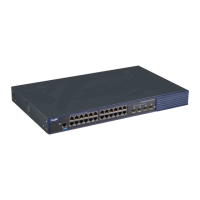Command Reference OSPFv3 Commands
spi specifies a security parameter index, in the range from 256 to
4294967295.
null specifies the null encryption mode.
md5 specifies the MD5 authentication mode.
sha1 specifies the SHA1 authentication mode.
0 indicates that a key is displayed in the plain-text format.
7 indicates that a key is displayed in the cipher-text format.
key specifies an authentication key.
authentication ipsec spi
spi [ md5 | sha1 ] [ 0 | 7 ] key
Specifies OSPFv3 authentication.
Authentication configuration on two neighboring devices must
be consistent. The service password-encryption command
enables a key to be displayed in the cipher-text format.
spi specifies a security parameter index, in the range from 256 to
4294967295.
md5 specifies the MD5 authentication mode.
sha1 specifies the SHA1 authentication mode.
0 indicates that a key is displayed in the plain-text format.
7 indicates that a key is displayed in the cipher-text format.
key specifies an authentication key.
No virtual link is defined by default
hello-interval: 10 seconds;
dead-interval: four times of the hello-interval;
retransmit-interval: five seconds;
transmit-interval: one second.
Authentication and encryption are not performed by default.
Routing process configuration mode
In the OSPFv3 AS, all the areas must be connected with the backbone area to ensure that they can
learn the routes of the whole OSPFv3 AS. If an area cannot be directly connected with the backbone
area, it can connect it through a virtual link.
The virtual link shall not be in the stub or NSSA area.
configuration, dead-interval and instance shall be configured consistently on both sides of the
virtual link neighbors, otherwise neighboring relationship cannot be set up between the virtual
neighbors.
The following example configures a virtual link.
Ruijie(config)# ipv6 router ospf 1
Ruijie(config-router)# area 1 virtual-link 192.1.1.1

